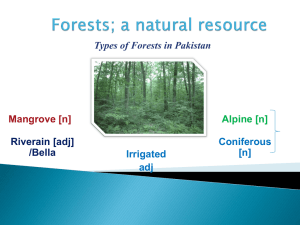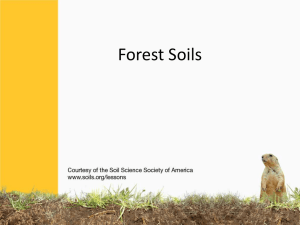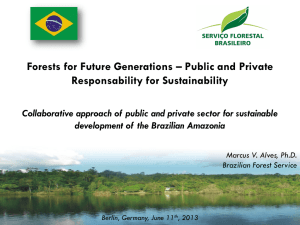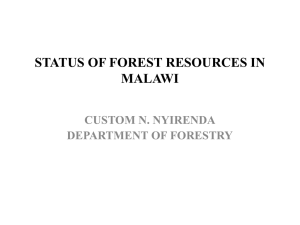ch7 and 10 ppt part I
advertisement
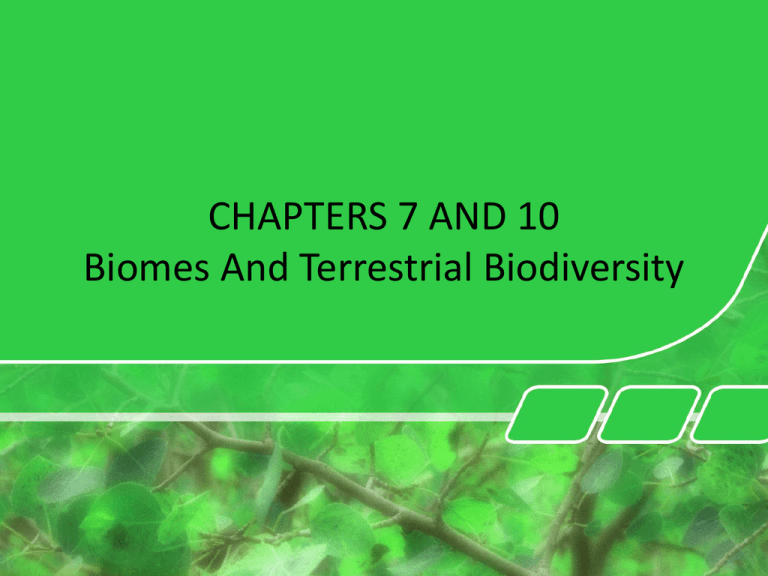
CHAPTERS 7 AND 10 Biomes And Terrestrial Biodiversity BIOMES • Large terrestrial regions with similar characteristics- latitude is a key • Climate is the most important factor in defining a biome • Precipitation is the main limiting factor for vegetation found in a biome (joshua tree is a xerophyte- lives without much water - another example is the bromeliad) Natural Capital: Average Precipitation and Average Temperature as Limiting Factors There Are Three Major Types of Deserts • Tropical deserts ex. Sahara-hot and dry • Temperate deserts ex. Mojave • Cold deserts ex. Gobi • Fragile ecosystem – – – – – Slow plant growth Low species diversity Slow nutrient recycling Lack of water Soil takes a while to recover Desert Biomes • Occur in interiors of continents • Intense heat and evaporation during the day and cooler nights due to rapid heat loss • Little vegetation- plants have deep roots, roots that spread out, spines, waxy leaves, no leaves, store water in tissue (succulent), open pores at night • Animals- long ears or legs to dissipate heat, thick skin, small in size, sleep during the day Threats to Deserts • • • • • • Overgrazing Erosion/desertification SUVs breaking the surface crust Climate - change caused drought Human population growth Mining There Are Three Major Types of Grasslands • Tropical- Savanna • Grazing animals • Browsing animals • Temperate – Tall-grass prairies – Short-grass prairies -Winds blow continuously • Arctic tundra: fragile biome – Treeless plains, covered with ice and snow except for about 8 weeks during summer when most plant growth occurs – Soils forms 17,000 ya • Alpine tundra- occurs above limit of tree growth but below permanent snow line. Receives more sunlight than arctic tundra Grasslands… • • • • Occur mostly in the interiors of continents Experience seasonal drought Are grazed by large herbivores Experience occasional fires Monoculture Crop Replacing Biologically Diverse Temperate Grassland Permafrost- underground soil which is permanently frozen. Only the top layer thaws. • Found In The Arctic TUNDRA • Permafrost keeps most snow melt from draining into the ground. Many shallow lakes, marshes, bog and ponds form. Mosquitoes, black flies and other insects serve as food for migratory birds that nest and breed here. Temperate Shrubland: Nice Climate, Risky Place to Live • Chaparral • Near the sea: nice climateS. California, Mediterranean, Central Chile • Prone to fires in the dry season and mudslides in the rainy season There Are Three Major Types of Forests • Tropical rain forests – High temperature and moisture – Stratification of specialized plant and animal niches- high biodiversity – Little ground level vegetation – Rapid recycling of scarce soil nutrients – Broadleaf, evergreen trees – High net primary productivity • Temperate deciduous forests – – – – Temperature and moisture Broad-leaf trees Slow rate of decomposition: significance Nutrient-rich soil • Evergreen coniferous forests: boreal and taigas – Temperature and moisture – Few species of cone: bearing trees – Slow decomposition: significance • Coastal coniferous forest- Scandanavia • Temperate rain forests- Pacific NW (Olympic National Rain Forest) Why are Forests Important? • Traditional medicines come from the forest (80% of the population uses) • Many chemicals are used in medicines • Are habitats to 2/3 of all terrestrial species • ¼ of world’s people depend on for their livelihoods Reintroducing Gray Wolves to Yellowstone • Around 1800-350,000 wolves over 48 states • 1850–1900: decline due to human activity (shot, poisoned, or trapped) • U.S. Endangered Species Act: 1973 –only 100 wolves remained • 1995–1996: relocation of gray wolves to Yellowstone Park – Helped to restore the biodiversity • 2008: Gray wolf is still endangered in many states, but not Alaska, Idaho, Montana and several other states. The recovery is considered a great success for the ESA. • Is considered a keystone species- preys on elk that keeps many plant populations in check (and then beavers and songbirds). Provide uneaten meat for scavengers (vultures, bears, bald eagles, foxes…) Sustaining Terrestrial Biodiversity • Forests account for about 30% of Earth’s land • Classified by age and structure • Old-growth or primary forest –not disturbed for 200+ years – 36% of world’s forests-high biodiversity • Second-growth forest –secondary succession – 60% of world’s forests • Tree plantation, tree farm or commercial forest (managed forest) – 4% of world’s forests-low biodiversity (1 or 2 species) • May supply most of the industrial wood in the future Russia, Canada, Brazil, Indonesia, Papua New Guinea • Most of the world’s forests are in Russia, Canada, Brazil, Indonesia, Papua New Guinea • Most of the world’s tree plantations are in China, India and the US • Rubber tree plantation in China Transitional Page Unsustainable Logging is a Major Threat to Forest Ecosystems • Increased erosion • Sediment runoff into waterways • Habitat fragmentation • Loss of biodiversity • Invasion by – Nonnative pests – Disease • Major tree harvesting methods: – Selective cutting – Clear-cutting – Strip cutting Building Roads into Previously Inaccessible Forests Natural Capital Degradation Building roads into inaccessible forests causes destruction, and degradation Major Tree Harvesting Methods Advantages and Disadvantages of Clear-Cutting Forests






